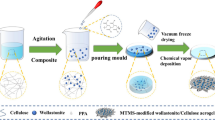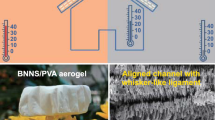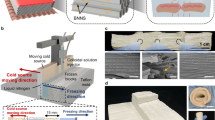Abstract
Radiative cooling and evaporative cooling, as the common heat dissipation strategies in the nature, are considered as promising alternatives to conventional ways for providing huge cooling capacity without energy consumption and waste discharge. Herein, inspired by natural creatures’ intelligently utilization of their own unique functionalities to fight against the extremely hot surroundings, a hydrophobized bacterial cellulose (BC) aerogel/polyvinyl alcohol (PVA) hydrogel bilayer gel combining radiative and evaporative cooling together was fabricated through facile and effortless solvent exchange, freeze dry, hydrophobization and dip-coating. The as-obtained bilayer gel shows high visible reflectance (98.8%) and emissivity in atmospheric window band (0.86) due to the inherent fiber structures of BC aerogel, contributing to the huge reduction in heat input and strong dissipation of thermal aggregation. Experimental observations indicated that the evaporation of the water swollen in hydrogel allow for sub-ambient temperature drops of ~ 18 °C under direct sunlight. After combining hydrophobized BC aerogel and PVA hydrogel, the followed validation tests demonstrated that a temperature difference of 16.4 °C could be obtained by covering the roof with bilayer gel attributing to the synergistic effect of radiative cooling and evaporative cooling. Moreover, the water contact angle of 142° gained from the hydrophobization endows the bilayer gel with the great resistance against the collapse of structure and failure of cooling properties resulting from water. Additionally, the facile and effortless fabrication approach makes scalable preparation possible. Therefore, this easily fabricated bilayer gel with great radiative and evaporative properties shows promising applications in building cooling and maintenance and residential thermal comfort.









Similar content being viewed by others
Data availability
All materials are authentic.
References
Brambilla A, Bonvin J, Flourentzou F, Jusselme T (2018) Life cycle efficiency ratio: a new performance indicator for a life cycle driven approach to evaluate the potential of ventilative cooling and thermal inertia. Energ Build 163:22–33. https://doi.org/10.1016/j.enbuild.2017.12.010
Chang Z, Feng D, Huang Z, Liu X (2018) Electrochemical deposition of highly loaded polypyrrole on individual carbon nanotubes in carbon nanotube film for supercapacitor. Chem Eng J 337:552–559. https://doi.org/10.1016/j.cej.2017.12.095
Cui S, Ahn C, Wingert MC, Leung D, Cai S, Chen R (2016) Bio-inspired effective and regenerable building cooling using tough hydrogels. Appl Energy 168:332–339. https://doi.org/10.1016/j.apenergy.2016.01.058
Fathi S, Kavoosi A (2021) Effect of electrochromic windows on energy consumption of high-rise office buildings in different climate regions of Iran. Sol Energy 223:132–149. https://doi.org/10.1016/j.solener.2021.05.021
Feng C, Yang P, Liu H, Mao M, Liu Y, Xue T, Fu J, Cheng T, Hu X, Fan HJ, Liu K (2021) Bilayer porous polymer for efficient passive building cooling. Nano Energy 85:105971. https://doi.org/10.1016/j.nanoen.2021.105971
French AD (2013) Idealized powder diffraction patterns for cellulose polymorphs. Cellulose 21:885–896. https://doi.org/10.1007/s10570-013-0030-4
Fu H, Baltazar J, Claridge D (2021) Review of developments in whole-building statistical energy consumption models for commercial buildings. Renew Sust Energ Rev 147:111248. https://doi.org/10.1016/j.rser.2021.111248
Kitagawa H, Asawa T, Kubota T, Trihamdani AR, Sakurada K, Mori H (2021) Optimization of window design for ventilative cooling with radiant floor cooling systems in the hot and humid climate of Indonesia. Build Environ 188:107483. https://doi.org/10.1016/j.buildenv.2020.107483
Li D, Liu X, Li W, Lin Z, Zhu B, Li Z, Li J, Li B, Fan S, Xie J, Zhu J (2021a) Scalable and hierarchically designed polymer film as a selective thermal emitter for high-performance all-day radiative cooling. Nat Nanotechnol 16:153–158. https://doi.org/10.1038/s41565-020-00800-4
Li Z, Gou M, Yue X, Tian Q, Yang D, Qiu F, Zhang T (2021b) Facile fabrication of bifunctional ZIF-L/cellulose composite membrane for efficient removal of tellurium and antibacterial effects. J Hazard Mater 416:125888. https://doi.org/10.1016/j.jhazmat.2021.125888
Li Z, Qiu F, Yue X, Tian Q, Yang D, Zhang T (2021c) Eco-friendly self-crosslinking cellulose membrane with high mechanical properties from renewable resources for oil/water emulsion separation. J Environ Chem Eng 9:105857. https://doi.org/10.1016/j.jece.2021.105857
Lu Z, Strobach E, Chen N, Ferralis N, Grossman J (2020) Passive sub-ambient cooling from a transparent evaporation-insulation bilayer. Joule 4:2693–2701. https://doi.org/10.1016/j.joule.2020.10.005
Mandal J, Yang Y, Yu N, Raman AP (2020) Paints as a scalable and effective radiative cooling technology for buildings. Joule 4:1350–1356. https://doi.org/10.1016/j.joule.2020.04.010
Nishiyama Y, Sugiyama J, Chanzy H, Langan P (2003) Crystal structure and hydrogen bonding system in cellulose Iα from synchrotron X-ray and neutron fiber diffraction. J Am Chem Soc 125:14300–14306. https://doi.org/10.1021/ja037055w
Oh M, Jang K, Kim Y (2021) Empirical analysis of building energy consumption and urban form in a large city: a case of Seoul. South Korea Energ Build 245:111046. https://doi.org/10.1016/j.enbuild.2021.111046
Peng Y, Li W, Liu B, Jin W, Schaadt J, Tang J, Zhou G, Wang G, Zhou J, Zhang C, Zhu Y, Huang W, Wu T, Goodson KE, Dames C, Prasher R, Fan S, Cui Y (2021) Integrated cooling (i-Cool) textile of heat conduction and sweat transportation for personal perspiration management. Nat Commun 12:6122. https://doi.org/10.1038/s41467-021-26384-8
Saikia A, Debbarma N, Karak N (2019) Renewable resource based hyperbranched epoxy thermosetting nanocomposite with cellulose nanofiber as a sustainable material. Cellulose 26:4743–4755. https://doi.org/10.1007/s10570-019-02443-8
Sugio F, Odgerel C, Ken T, Annette D, Jukka T (2018) Global asbestos disaster. Int J Env Res Pub He. https://doi.org/10.3390/ijerph15051000
Tang K, Dong K, Li J, Gordon M, Reichertz F, Kim H, Rho Y, Wang Q, Lin C, Grigoropoulos C, Javey A, Urban J, Yao J, Levinson R, Wu J (2021) Temperature-adaptive radiative coating for all-season household thermal regulation. Science 374:1504–1509. https://doi.org/10.1126/science.abf7136
Tian Q, Qiu F, Yue X, Li Z, Zhao B, Zhang T (2021a) Surface structure regulation of wastewater flocculated sludge for hierarchical superhydrophobic ceramic coating. J Environ Chem Eng 9:106851. https://doi.org/10.1016/j.jece.2021.106851
Tian Y, Shao H, Liu X, Chen F, Li Y, Tang C, Zheng Y (2021b) Superhydrophobic and recyclable cellulose-fiber-based composites for high-efficiency passive radiative cooling. ACS Appl Mater Interfaces 13:22521–22530. https://doi.org/10.1021/acsami.1c04046
Wei G, Ding J, Zhang T, Qiu F, Yue X, Yang D, Wang Z (2019) In situ fabrication of ZnO nanorods/Ag hybrid film with high mid-infrared reflectance for applications in energy efficient windows. Opt Mater 94:322–329. https://doi.org/10.1016/j.optmat.2019.06.004
Wu W, Lin S, Wei M, Huang J, Xu H, Lu Y, Song W (2020) Flexible passive radiative cooling inspired by Saharan silver ants. Sol Energy Mater Sol Cells 210:110512. https://doi.org/10.1016/j.solmat.2020.110512
Xu G, Xia H, Chen P, She W, Zhang H, Ma J, Ruan Q, Zhang W, Sun Z (2021) Thermochromic hydrogels with dynamic solar modulation and regulatable critical response temperature for energy-saving smart windows. Adv Funct Mater. https://doi.org/10.1002/adfm.202109597
Xue X, Qiu M, Li Y, Zhang QM, Li S, Yang Z, Feng C, Zhang W, Dai JG, Lei D, Jin W, Xu L, Zhang T, Qin J, Wang H, Fan S (2020) Creating an eco-friendly building coating with smart subambient radiative cooling. Adv Mater 32:1906751. https://doi.org/10.1002/adma.201906751
Yang J, Yao J, Ma Y (2021a) A highly flexible, renewable and green alginate polymer for electroactive biological gel paper actuators reinforced with a double-side casting approach. Cellulose 28:3647–3662. https://doi.org/10.1007/s10570-021-03784-z
Yang J, Zhang X, Zhang X, Wang L, Feng W, Li Q (2021b) Beyond the visible: bioinspired infrared adaptive materials. Adv Mater 33:2004754. https://doi.org/10.1002/adma.202004754
Yue X, Zhang T, Yang D, Qiu F, Wei G, Lv Y (2019) Robust Janus fibrous membrane switchable infrared radiation properties for potential building thermal management application. J Mater Chem A 7:8344–8352. https://doi.org/10.1039/C9TA00738E
Zhang H, Ly KCS, Liu X, Chen Z, Yan M, Wu Z, Wang X, Zheng Y, Zhou H, Fan T (2020) Biologically inspired flexible photonic films for efficient passive radiative cooling. Proc Natl Acad Sci USA 117:14657–14666. https://doi.org/10.1073/pnas.2001802117
Zhao B, Yue X, Tian Q, Qiu F, Zhang T (2022) Controllable fabrication of ZnO nanorods@cellulose membrane with self-cleaning and passive radiative cooling properties for building energy-saving applications. Cellulose 29:1981–1992. https://doi.org/10.1007/s10570-021-04408-2
Zhou H, Zhang T, Yue X, Peng Y, Qiu F, Yang D (2019) Fabrication of flexible and superhydrophobic melamine sponge with aligned copper nanoparticle coating for self-cleaning and dual thermal management properties. Ind Eng Chem Res 58:4844–4852. https://doi.org/10.1021/acs.iecr.9b00041
Zhou Y, Wang S, Peng J, Tan Y, Li C, Boey FYC, Long Y (2020) Liquid thermo-responsive smart window derived from hydrogel. Joule 4:2458–2474. https://doi.org/10.1016/j.joule.2020.09.001
Acknowledgments
This work has been supported by China Postdoctoral Science Foundation (2020M681740 and 2021T140578), National Natural Science Foundation of China (21706100 and 21878132), and Non-Ferrous Metals and Material Processing New Technology Key Laboratory of Ministry of Education/Guangxi Key Laboratory of Optoelectronic Materials and Devices (20 KF-27).
Author information
Authors and Affiliations
Contributions
BCZ: Conceptualization, Methodology, Visualization, Writing-original draft, Data curation. XJY: Investigation, Formal analysis, Validation. QT: Investigation, Formal analysis, Validation. FXQ: Supervision. YQL: Supervision. TZ: Supervision, Writing-review & editing.
Corresponding authors
Ethics declarations
Conflicts of interest
No conflict of interest exists in the submission of this manuscript, and manuscript is approved by all authors for publication. I would like to declare on behalf of my co-authors that the work described was original research that has not been submitted previously.
Ethics approval
This paper does not involve human or animal experiments.
Additional information
Publisher's Note
Springer Nature remains neutral with regard to jurisdictional claims in published maps and institutional affiliations.
Supplementary Information
Below is the link to the electronic supplementary material.
Supplementary file1 (MP4 5991 kb)
Rights and permissions
About this article
Cite this article
Zhao, B., Yue, X., Tian, Q. et al. Bio-inspired BC aerogel/PVA hydrogel bilayer gel for enhanced daytime sub-ambient building cooling. Cellulose 29, 7775–7787 (2022). https://doi.org/10.1007/s10570-022-04749-6
Received:
Accepted:
Published:
Issue Date:
DOI: https://doi.org/10.1007/s10570-022-04749-6




